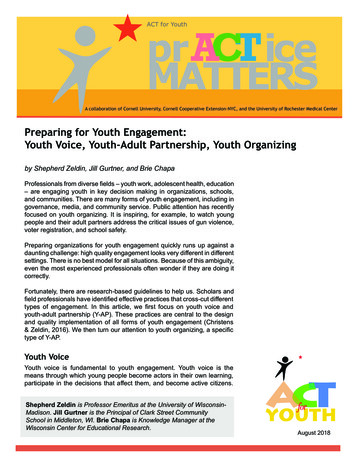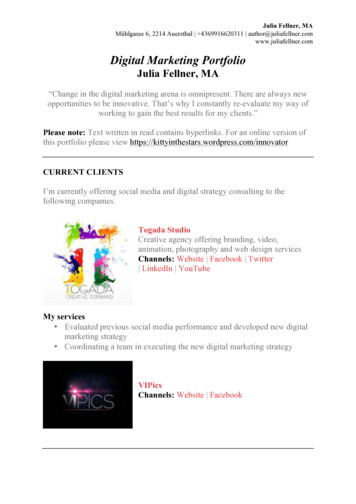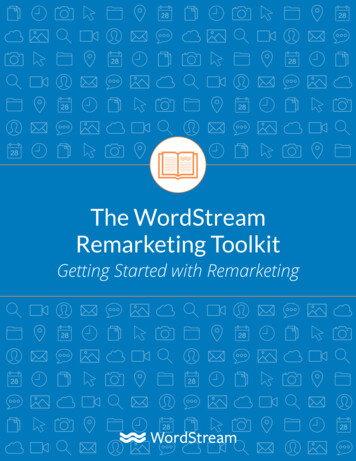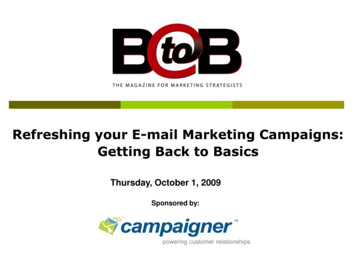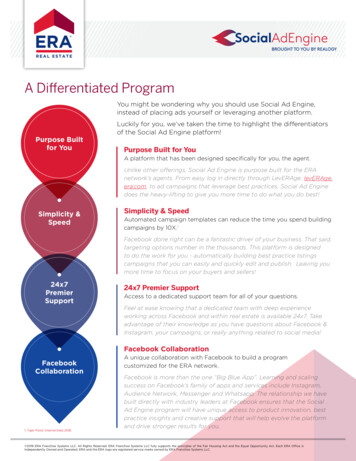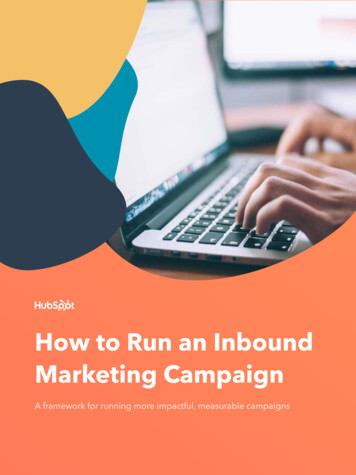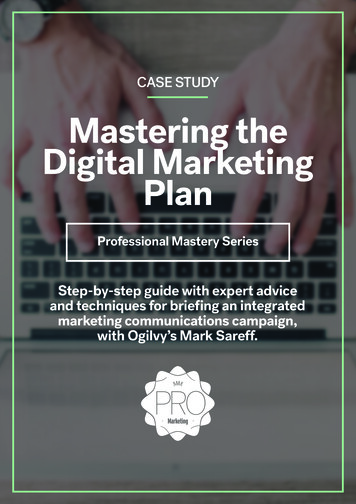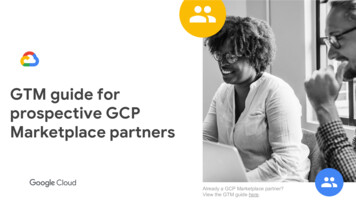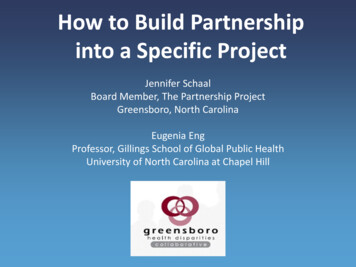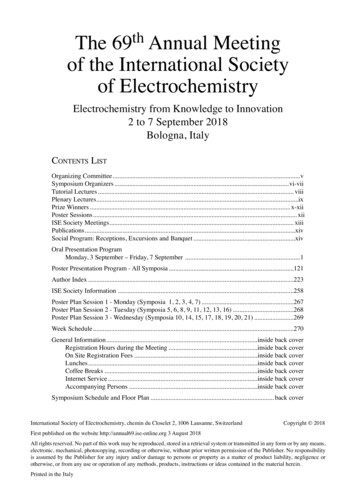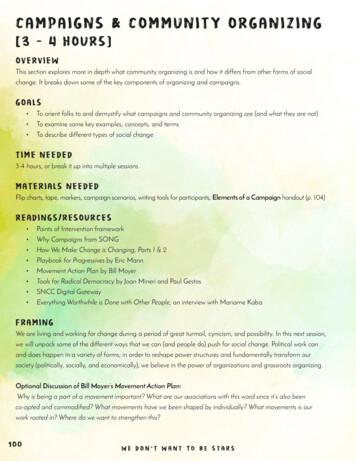
Transcription
CAMPA I G N S & C O MMUNI T Y ORGAN IZ ING[3 - 4 HOURS]OV ER VI EWThis section explores more in depth what community organizing is and how it differs from other forms of socialchange. It breaks down some of the key components of organizing and campaigns.G OA L S To orient folks to and demystify what campaigns and community organizing are (and what they are not)To examine some key examples, concepts, and termsTo describe different types of social changeT I M E NEED ED3-4 hours, or break it up into multiple sessionsM A T ER I AL S NE E DE DFlip charts, tape, markers, campaign scenarios, writing tools for participants, Elements of a Campaign handout (p. 104)R E A DI NGS/R ESO URCE S Points of Intervention frameworkWhy Campaigns from SONGHow We Make Change is Changing, Parts 1 & 2Playbook for Progressives by Eric MannMovement Action Plan by Bill MoyerTools for Radical Democracy by Joan Mineri and Paul GestosSNCC Digital GatewayEverything Worthwhile is Done with Other People, an interview with Mariame KabaF RA MI NGWe are living and working for change during a period of great turmoil, cynicism, and possibility. In this next session,we will unpack some of the different ways that we can (and people do) push for social change. Political work canand does happen in a variety of forms; in order to reshape power structures and fundamentally transform oursociety (politically, socially, and economically), we believe in the power of organizations and grassroots organizing.Optional Discussion of Bill Moyer’s Movement Action Plan:Why is being a part of a movement important? What are our associations with this word since it’s also beenco-opted and commodified? What movements have we been shaped by individually? What movements is ourwork rooted in? Where do we want to strengthen this?1 00We DON’T WANT to be STARS
DI FF ER EN T FO RMS O F SO CIAL CH A N G EThis is a chart many folks have been using for years to illustrate different approaches to social change work. Weexplore this content not to shame or condescend to different forms of social change, but rather to get clearer andmore precise about how groups are – or are not – contending for power. It also helps us determine how we canrelate to each other across different approaches to bring about the biggest impact, and/or work to do no harm.We know these distinctions are sometimes overstated or less simple out in the world; for example, some communityorganizations may also include service in their outreach model (such as the Dream Defenders’ Books and Breakfastprogram modeled on the works of the Black Panthers, or Southerners On New Ground’s work bailing blackcaregivers out of jail). Still, the broad categories are useful to explore and important to understand.Create an empty chart, then go through and fill it out together. It is good for you as the facilitator to haveprepared some relevant examples by filling out this chart beforehand on your own.wh atgo a l /outcomewhat’s t heso l utio n tothe pro b lemrel atio n shiptoco mmun it ydoes thisaddress rootcause of harmor oppression?se r v icer e sou r c e s toa ll e v i a t e su f f e r i n g,l e gal r es our c e s ,food , c lo t h e spr ovi de fo rpeo ple’ s ba sicn ee dsdepen ds –often h el pin gis cons i der ed‘ ch ar i ty’advoca c yev e n t s , lobby i n g ,c a l l s e n a tor s ,petitions, etc.s mal l g rou pus u a lly as k i nge l e cto r s to d o theright t hings pe a ks on behal fof a c o mm u n ity ,n ot n ec es s ar i ly asa pa r t of i tincreasec on s c i o u s ne s s“ IF pe o p le g o t th e irm in ds r igh t. . ”t eachin gn ot n ec essarily,unless p ai red w i thact ion.c on n e c t i o n ! li n k tom ov e m e n t ! s h ow o fs t re n g t hs h o w o f fo r ce wil lch an ge the r u le sv ar ies (e s pecia l lyin soc i al med ia er a ,s po n tan eou s )n ot wi t houtm oment u m,follow-u pd ir e c tact i o n /co mm u n i t yorg a n i z i n ga bi li t y to be e xp e r t si n ow n l i v e s &s h ape s o l u t i o n s top r o ble m sdir ectly affec t e dpeo ple w or kin gtogeth e r toch al len g e po w ersh oul d be of, b y, and fort h e com muni ties – usi ngdire ct acti on to e x po secri s is a nd tie d ec i s ionmak e rs’ h andse l e c tor a lg e t p e o p l e e le c t edto g ove rn a n c e r o l e sth at s h a r e y o u rvaluesw in n i ng electi on st h r o u gh vo ti ng(m aj o r it y r u l e)de pe nds , b ut g ene ral lyask i ng t he m to ta kea c t i o n in t he f o rm ofvo t i ng or ge t ti n g other sto vo teex. red cross,food pa n tryex. acl u , hrce d u c a ti o nex. stu d y group,billboa r dsm obi li z i ngex. vig i ls,marches, ralli e sl eg alp r o t e c t v uln e r a b lep e ople t h r o u g hth e c ou r ts / j u st i c es y st e mtr yi ng to sto p ‘ba d l a w s ’a ka m u s l i m ban, ma s sdi scr im i n a ti o n o f tr anspeop l e, etc., t h r oughl i ti ga t io n , cl a s s a ct io n , et c.usual ly l aw yer s, le galgroups go “find ” di rect lyaffe cte d c ommun i t ies an da sk t he m to be p lai nt i f f .oft e n i ncred ibly slow.THE BEST OF OUR ORGANIZING TRADITIONSnon ot usu allyyesch an g es t hose inpow er b ut notn ec ess a r i ly pow e rrela ti o n shipsNO101
K EY TAK E-AW AYS Organizations are made up of people and are a fundamental building block of movement.One organization, community of people, or campaign cannot bring about liberation.We are part of a movement.Movements are made up of mobilizing, organizing, direct service, labor, media, civil society, andindividual activists.You can do direct service and have revolutionary politics individually!Organizing is the method that is working to disrupt and confront the root causes of oppression withthose impacted by that oppression or injustice, which is why it’s so hard and so important.People are our power, which is why if our organizations are not growing, they are dying.We must change the rules (laws) and transform the institutions that govern our lives so they work for themany not the few.NI TT Y GR I TT Y: CAMPAIGNS AND O R G A N I Z I N GThroughout this curriculum, we have been talking about power: Power Over, Power With, and Power from Within. Inour groups, we work to grow our individual and collective power and bring that to bear on the systems, institutions,and policies that harm us. We have also been talking about different forms of social change. Now we are going tofocus in on campaigns as one crucial tool and vehicle for us to express our politics and vision.C O M MUN I T Y O R G A N I Z I N G i s: People building a base that has the shared vision to act together to build power,challenge power, and change power relationships and communities. This is importantbecause the power to make change lies in the hands of the people that those changes affectmost directly.Sustained fights (beginning, middle, end) to win concrete policy and institutionalchange on issues that impact your constituency.C A MP A I GN S a r e : 102Time bound, specific efforts to accomplish a set of goals, which is why there can beeducation or electoral campaigns.Within your campaign, your strategy is your roadmap for how you are going toaccomplish your goals, and the tactics are individual steps it will take to win! You can’trun a 12-month campaign to end white supremacy. Defeating white supremacy requires alot of different campaigns taking on different parts of the system (for example, changingColumbus Day to Indigenous Peoples’ Day in New Mexico, plus getting cops out of schools,plus the Green New Deal, plus lots more). For a campaign, cut it down into a smallerchunk with a target.We DON’T WANT to be STARS
WOR K SH OPPING CAMPAIGN EX A MPLESHave participants read the following example out loud to the full group:T H E CAM PAIGN FO R T HE WEEKEN DLabor movement organizers worked for many years to create the concept of the ‘weekend’: two days ofrest after 5 days of work, totaling a 40-hour workweek. According to Dean Baker, “the 40-hour workweekbecame the standard in 1937 with the passage of the Fair Labor Standards Act. This bill, which also put inplace a federal minimum wage, required a premium of 50 percent of pay for any hours that an employerrequired in excess of 40 hours a week. Unions had pressed for similar rules for decades, but it took thepower of a militant labor movement, coupled with a sympathetic president and Congress to finally makethe 40-hour workweek a standard across the country.”F RAM I NG This win is so important because it shows how an idea had to be born and spread before it could be won.Because of this important campaign, even those of us who work weekends understand the idea thatworkers should be entitled to a weekend. Campaigns change the nature of how people understand power.This is an example of a campaign that profoundly impacts women, who have always done the vastmajority of domestic work, both inside and outside their own homes. Weekends allow a little bit morebreathing room to accomplish domestic work, and, when possible, to take a few moments of rest for oneself.Discussion:Ask the full group: What is a campaign that matters to you? Alternatively, prepare a scenario that is topicallyor locally relevant. For example, as a result of local organizing in 2019, the Kansas City City Council passed anordinance making all public transportation free. What was the demand? Who was the target? What impact did this campaign have on culture and policy?EL E MEN T S OF A CAMPAIGNThis activity explores the concepts in the chart on page 101, Elements of a Campaign. Write up each element andits definition on large paper. Invite someone in the group to read one, and then have everyone find a partner todiscuss the concept for a specified length of time. Popcorn out reflections, then read the next definition and haveeveryone find a new discussion partner. Repeat until complete. Save time for group conversation, if needed.“ Great Campaigns are like great love affairs: suddenly, you have time you didn’t know you had –to have pizza, have sex, to take slow walks. Time moves differently, and you are swept up in it all.The same is true of great campaigns.” – Ai-jen PooTHE BEST OF OUR ORGANIZING TRADITIONS103
V I S I ON: Campaigns, at their core, are about theTA R G ETS : A target is a person who haswillingness to get specific and concrete and moveinto action as we contest for power and justice. Thisrequires vision about what we want, how we want toget it, and how getting it will help us build towards thetown, county, city, state, country, and world we want.Every campaign organizer must be able to articulatewhy a campaign fits into this broader vision.the power to give you what you want (i.e., meetyour demands), and to whom you address yourdemands. It is helpful to conceptualize this personas your opponent, not your enemy. This is becausethere are many ways to get a target to do what youwant them to do. Some require placating, and somerequire firm confrontation. Your group does not wantto be so locked into negative feelings around a targetthat it will be hard to change tactics if you need to.For example, you might start a campaign that targetsyour mayor by appealing to their self-interest orstroking their ego. If this does not get you what youwant, you will need to escalate your tactics. That couldmean publicly calling out the mayor on what theyhave or have not done around your demand. At thatpoint, the mayor might be ready to give you what youwant and so you will have to be ready to be genuinelyfriendly again (de-escalate) in order to win yourcampaign. Secondary targets are those around atarget who influence them (this could be a co-worker,a spouse, a sponsor or funder, etc.).D E M AND S: The demand of a campaign issimply what you want. Your demand should be wellresearched and well understood by your organizinggroup. All organizers must be able to answer why thisis the demand, what it is, and what compromises onthe demand your group would and would not acceptas a “win.”IN NOV A T I ON: We are in a time when thenature of successful campaigns is changing. Thisis in large part due to the evolution of the digitalsphere, and how URL and IRL (in real life) organizinginteract. Additionally, technology has changed (andcontinues to change) how we interact with each other.Thus, some campaign tactics that worked beforeno longer do, and new options are emerging.Successful campaigns in this time will understandthe need to be curious, keep learning, keepexperimenting, and innovate.ESC A L A T I ON A ND DE -E SCALA T ION :Just like in direct actions, an understanding ofescalation and de-escalation is required for anyconfrontation with power. Escalating simply means“turning the heat up” on a target or situation, or beingwilling to ethically make a situation more conflictual,tense, or uncomfortable between your organizinggroup, your targets, and secondary targets. Deescalation means being willing to turn the heat downand calm a situation. This is difficult once we haveescalated, and our adrenaline is high. Most organizersare better at escalation or de-escalation with targets,but a strong organizer can do both as needed.10 4T I ME-B O UN D: Part of why campaigns can beso powerful (altering both material conditions andchanging lives) is because they have a timeline.A campaign might be one week or one year, but itmust have some time frame to keep up momentum.Long campaigns (five years or more) require differentplanning and execution than shorter ones.EX P EC T B A C KLA S H /CULT UR ECH A N G E A N D PO LI CY CH A N GE :One way we can work to secure our wins or advancesis by making sure we are prepared to see throughthe implementation of a win, and/or to weather thebacklash that can come from local, state, or countygovernments who do not want rights and accessexpanded for marginalized communities.We DON’T WANT to be STARS
L E AR NI NG FRO M O UR E XPE RI EN C ESMix and match the following exercises depending on the needs of group. Reflect together on the campaignexperience in the room. Consider a deeper dive with discussion questions about how campaigns fall flat, then discussaspirational demands for your context or run scenarios for practice.What is our personal experience with campaigns?If you are in a red state or rural area, it’s important to highlight that a lot of the materials and models of campaignscome from the coasts or blue states. In many ways, those of us navigating campaigns in red states are dealingwith hugely different conditions; we have different laws, different services, different opposition and backlash, anda different safety net. A lot of us in red states have also been burned by campaigns (both issue campaigns andelectoral campaigns) coming in from national organizations without relationships, humility, or a commitment tolong-term investment in our places and people.Where do you imagine (or know from experience) we often fall flat with campaigns? When we can’t decide what to focus on When we get stuck in research mode When we forget about implementation When we win and then are totally unprepared for the backlash that meets us When we allow in-fighting to destroy our groups before we even start our campaigns When we hold on too tightly to our plans even as the terrain is changingHow might we put this into practice, here and now?In small groups, look back at the 3 I’s exercise to consider rules or dominant beliefs that are harming yourcommunity, or do that exercise again with a specific local lens. Then consider: What’s an aspirational demand you have for your local community? Who is the target? Who can give it to you? What’s your vision this demand is tied to?Campaign Scenario:Using the following campaign scenario, have small groups make an outreach and escalation plan, including threethoughtful outreach and retention activities and three thoughtful escalation plans. You can make up other detailsthat will make this most useful to your group. Give people 45 minutes with a 5-minute report-back.Your coalition is mid-way through a campaign for universal pre-K at the county level. This will ensurethat all young people in the county ages 3 and up have full-time, age-appropriate childcare untilthey go to kindergarten. The target or decision-maker for this campaign is the county commission.There is organized opposition (fiscal conservatives, the local charter school, and racists).THE BEST OF OUR ORGANIZING TRADITIONS105
sphere, and how URL and IRL (in real life) organizing interact. Additionally, technology has changed (and continues to change) how we interact with each other. Thus, some campaign tactics that worked before no longer do, and new options are emerging. Successful campaigns in this time wi

